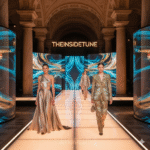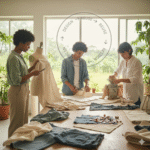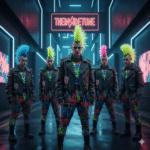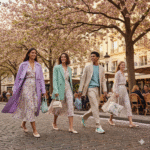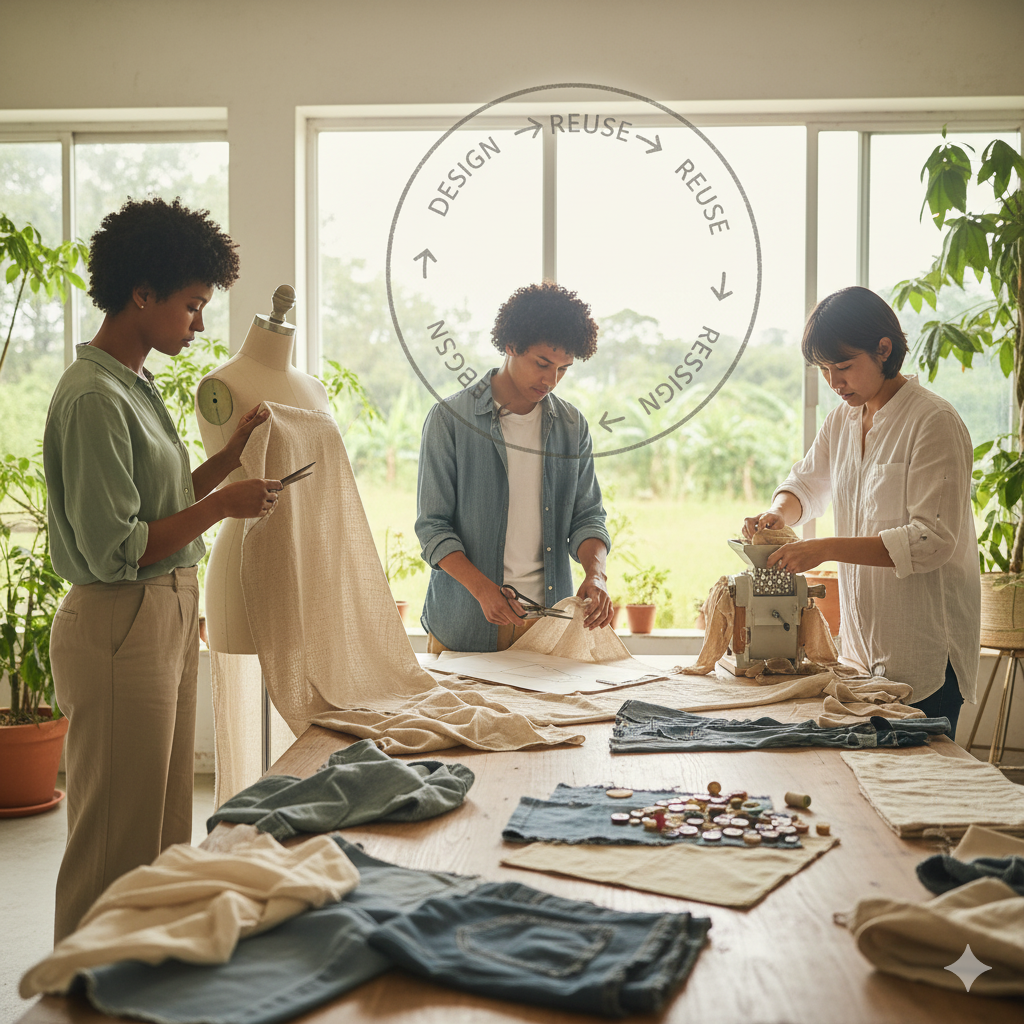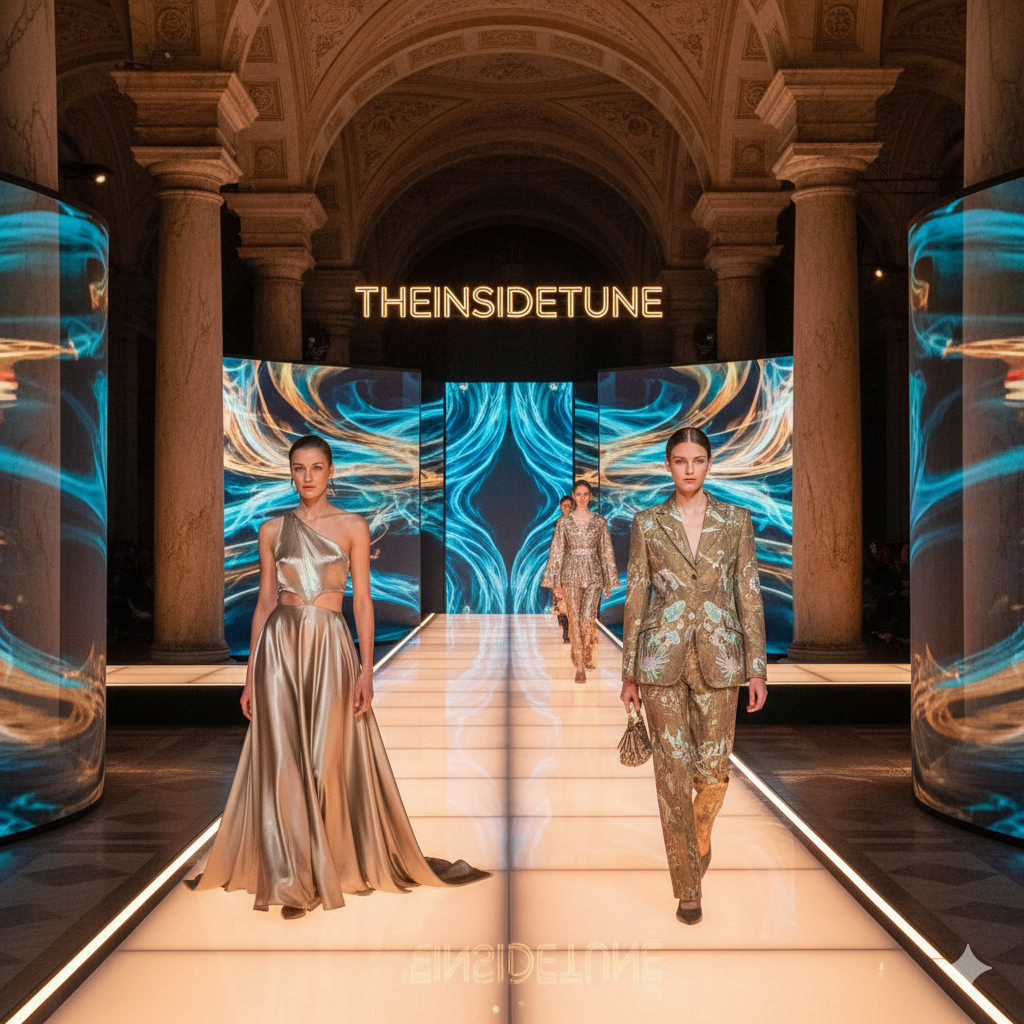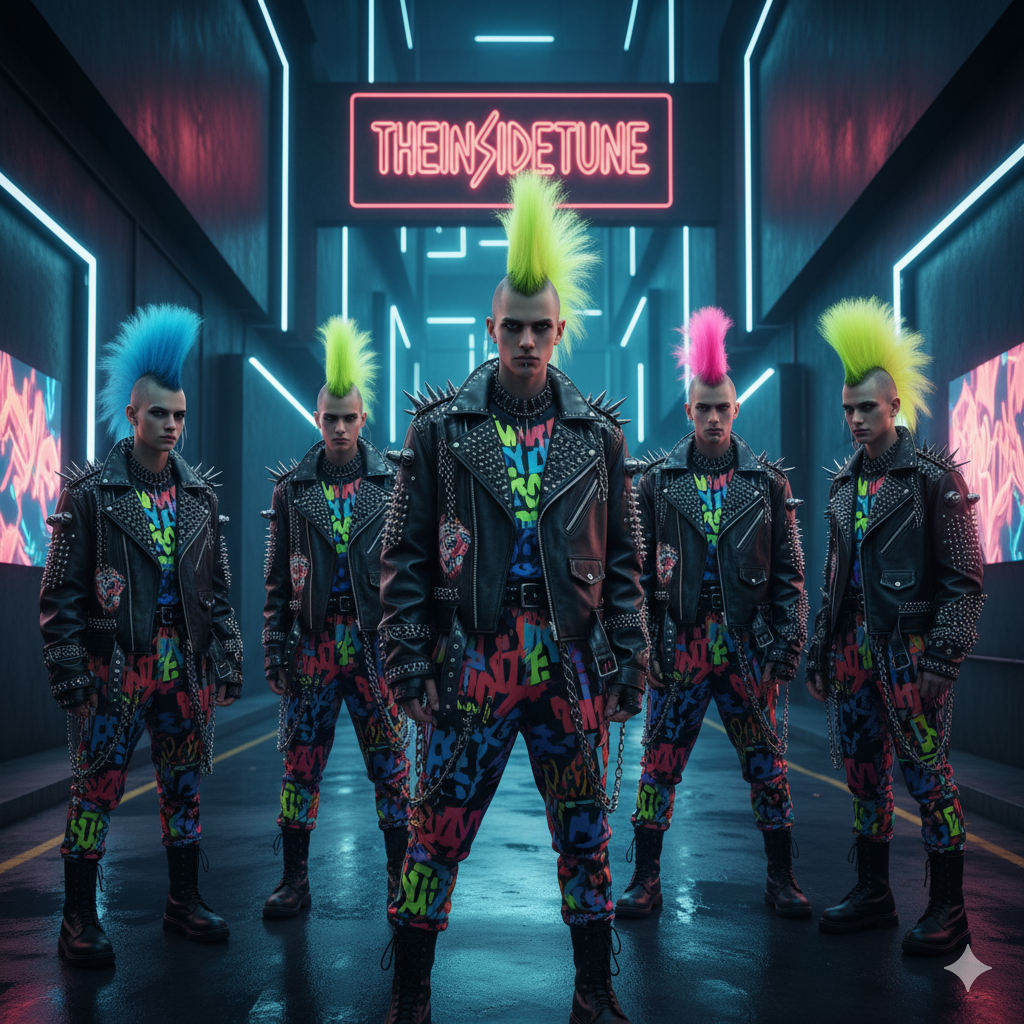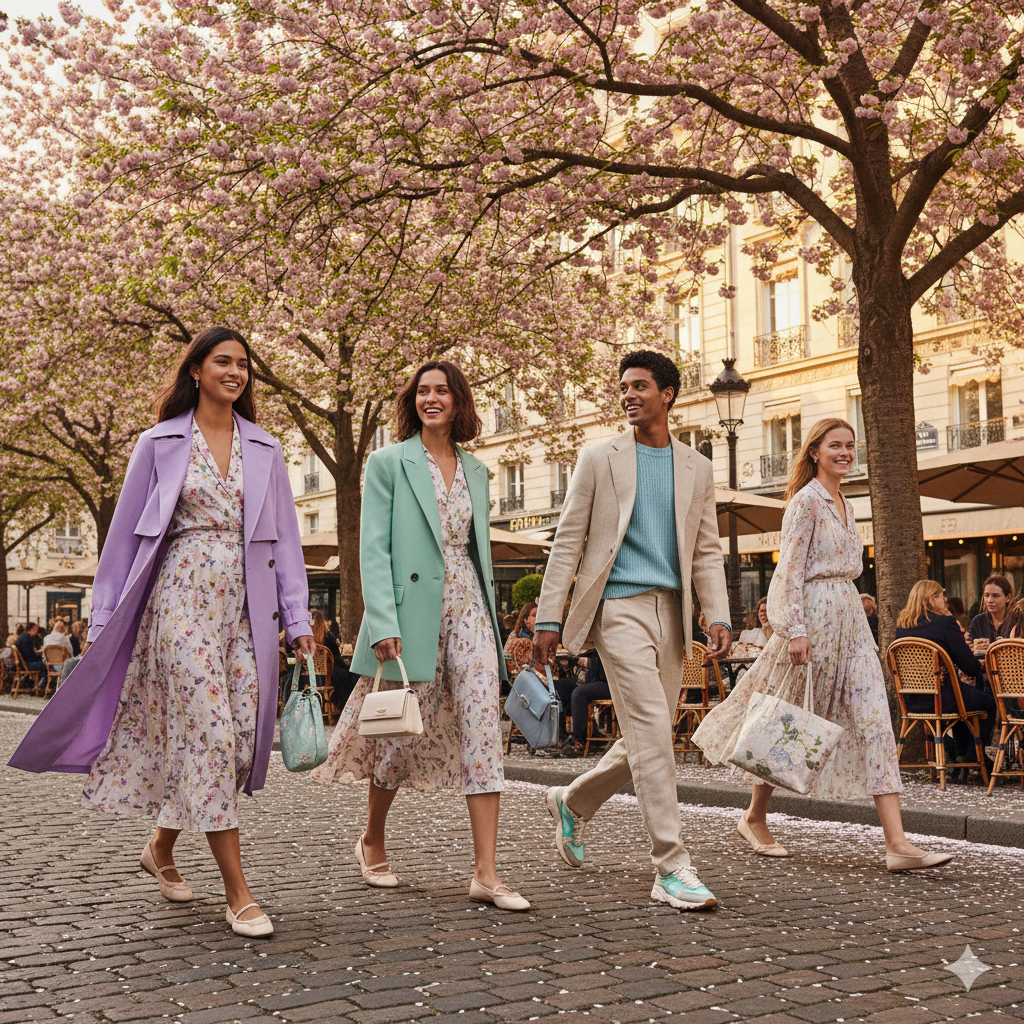The Circular Revolution 2025; Circular by Design, A Call to Brands and Consumers to Shape a Sustainable Future
Introduction – Why the Circular Revolution Matters Now
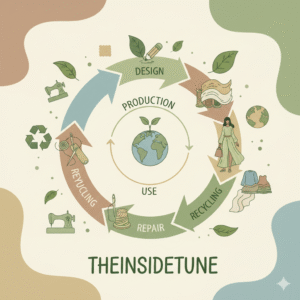
Everywhere you look today, there’s a new trend, a new drop, a new “must-have” item. Fashion moves fast—sometimes too fast. Shelves fill and empty in a matter of weeks, and behind the scenes, the planet pays the price. Piles of discarded clothes, mountains of plastic packaging, and endless factory waste have become the hidden cost of modern beauty and convenience.
But quietly, a new kind of creativity is rising—one that’s not just about how things look, but about how they live. This movement is called the Circular and Eco-Design Revolution, and it’s changing the way we think about everything we wear, use, and throw away.
At its heart, circular design is about giving products a longer, more meaningful life. Instead of the old “take, make, and toss” approach, it asks:
What if we could design things to be used again? What if waste wasn’t the end, but the beginning of something new?
This isn’t just about recycling or using organic fabrics (though those are important steps). It’s about reimagining the whole process—from how materials are chosen to how products are repaired, reused, and reborn. It’s about creating systems that mimic nature itself—where nothing is wasted and everything has purpose.
But here’s the thing: no single brand or consumer can make this shift alone.
Designers, makers, retailers, and buyers—we’re all connected in this loop. Every design choice, every purchase, every tiny act of care for a product adds up. When brands rethink their production and consumers change how they consume, real transformation happens.
So, this isn’t just a story about sustainability. It’s a story about shared creativity and collective responsibility. It’s about the power of both brands and individuals to reshape the future of design—one thoughtful choice at a time.
If you’re someone who believes fashion and design can be beautiful and kind to the planet, this is your moment to join in.
Welcome to the circular revolution—where innovation meets integrity, and where design begins again, in a better way.
The Problem — Why Linear Design Is Breaking the Planet
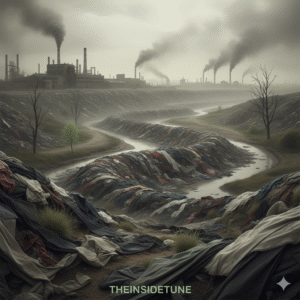
For decades, our entire design system has followed one simple formula: take, make, and throw away. It’s called a linear model, and on paper, it sounds efficient. You take raw materials from nature, make products, sell them, and when they’re no longer useful, you toss them out. Easy, right?
But when you zoom out and see the bigger picture, you realize this “simple” model has created one of the biggest crises of our time.
Every year, the world produces over 100 billion garments, yet more than 70% end up in landfills or incinerators. The same pattern repeats in furniture, electronics, packaging, and beauty industries. We’re making more, using faster, and wasting sooner. Products are designed to go out of style—or fall apart—just in time for the next collection to arrive. This isn’t innovation; it’s exhaustion—of our resources, our creativity, and our planet.
🧵 The Hidden Cost of “New”
Every new dress, smartphone, or home item begins with extraction: cotton fields, oil wells, and mining sites. Water is drained, forests are cleared, and carbon floods the atmosphere—all so we can keep the wheels of “newness” spinning.
The fashion industry alone is responsible for around 10% of global carbon emissions—that’s more than all international flights and shipping combined. And yet, only a small fraction of textiles are ever truly recycled. Most are burned, buried, or dumped, often in countries that had no part in creating them.
This linear cycle doesn’t just harm the planet—it hurts people. Behind every “cheap” product lies a chain of underpaid workers, unsafe factories, and communities living with pollution. The real price of fast design isn’t written on the tag; it’s written in the soil, the rivers, and the air we all share.
♻️ A Culture of Disposability
The saddest part? We’ve been taught to treat products—and sometimes even creativity—as disposable. Something rips? Buy another. The color fades? Toss it. There’s a new trend? Replace it. We’ve been told that happiness lies in the next purchase, not in the things we already own.
This mindset has separated us from the real essence of design: connection, durability, and purpose. When everything becomes replaceable, meaning disappears. And so does craftsmanship. The artistry, the emotion, the story behind a well-made piece—all get lost in the rush of consumption.
🌫️ When the Old System No Longer Works
Our planet is now sending clear signals that this system cannot continue. From melting glaciers to overflowing landfills, nature is shouting that it’s time to rethink. The linear model has reached its limit—it’s unsustainable, both environmentally and emotionally.
We can’t keep extracting more, producing faster, and wasting sooner. The future demands a new kind of creativity—one that restores instead of depletes, one that gives back more than it takes.
This is where circular and eco-design step in—not just as an alternative, but as a solution. It’s not about guilt; it’s about growth. It’s about reimagining design as a regenerative cycle, where materials, ideas, and energy keep flowing instead of ending.
And it all begins by facing the truth: the linear model isn’t just broken—it’s breaking us.
But the beauty of design is that it can evolve. And we, as creators and consumers, have the power to rewrite the system.
Understanding the Circular and Eco-Design Mindset — A New Way to Create
When we think about design, most of us imagine creativity, innovation, and beauty. But today, design has taken on a much deeper meaning — it’s no longer just about what we create, but how and why we create it. The way we design can either drain the planet or help heal it. And this is exactly where circular and eco-design step in — reshaping not just industries, but mindsets.
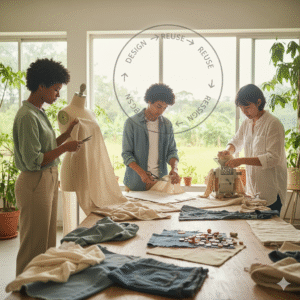
🌱 What Circular Design Really Means
The circular design philosophy begins with one radical idea: nothing should go to waste. It’s about seeing design as part of a loop, not a line. Instead of ending up in a landfill, products and materials keep circulating — through reuse, repair, remanufacturing, or recycling.
It asks designers to think far beyond the first sale.
👉 What happens after the customer buys this?
👉 Can it be disassembled easily?
👉 Can we design it so every part has another life waiting for it?
This mindset transforms design into a continuous process rather than a one-time act of creation. It mirrors nature’s perfect balance — where nothing is wasted, everything has value, and every ending becomes a new beginning.
In a circular world, a single fabric, a button, or a thread doesn’t just vanish after one use. It becomes part of an ongoing story — one that loops back into the system again and again.
Imagine a cotton shirt that, after years of wear, is recycled into yarn, then rewoven into a new garment. Or a pair of sneakers made from ocean plastics that, when worn out, get remade into soles for new ones. Circular design brings that vision to life.
🌿 Eco-Design: Responsible Creation from the Very Start
If circular design focuses on the afterlife of products, eco-design focuses on their birth. It’s about making conscious, thoughtful choices from the very first sketch — selecting materials, methods, and packaging that do the least harm and offer the most value.
Eco-designers ask:
-
How much water will this fabric need?
-
What happens if this material breaks down — will it pollute or nourish?
-
Can this packaging be composted, refilled, or returned?
-
Can this design be beautiful and biodegradable?
It’s design with empathy — for both people and the planet.
And contrary to what many think, eco-design doesn’t restrict creativity. It unlocks it. When designers are challenged to work with renewable or recycled resources, to reduce waste, or to make products that last longer, innovation naturally follows. Constraints become catalysts for creativity.
We see this in the rise of mushroom leather, pineapple fiber (Piñatex), plant-based dyes, and biodegradable materials that are transforming fashion and product design. Each material tells a story of rebirth, renewal, and responsibility.
♻️ From Ownership to Connection
Perhaps the biggest shift circular design invites is not technological, but emotional. It asks us — both brands and consumers — to redefine our relationship with the things we own.
In a linear world, ownership ends with disposal.
In a circular world, ownership means connection.
We start caring again. We value the craftsmanship behind what we buy. We repair instead of replace. We lend, swap, share, and resell — keeping objects alive and meaningful.
This creates not just less waste, but more appreciation. We reconnect with the idea that things can hold stories, memories, and worth beyond their market value. When you mend a jacket your grandmother once wore or buy a pre-loved piece that carries someone else’s story, you’re not just consuming — you’re continuing something.
That emotional durability — the sense that what we use has a history and a future — is what truly makes design sustainable.
🌍 Circular Design as a System — Not a Trend
It’s easy to see circular and eco-design as “the next big trend.” But they’re far more than that. They’re a new system — a smarter, fairer, and more resilient way to create and live.
Circular design works best when everyone is part of the loop:
-
Designers create for longevity, easy repair, and recycling.
-
Manufacturers use renewable energy and ethical processes.
-
Retailers offer take-back programs and rental options.
-
Consumers care for, reuse, and return products responsibly.
It’s a complete ecosystem — one where creativity doesn’t end at the point of sale. In fact, that’s where it begins.
And the impact goes far beyond sustainability. Circular systems can create new jobs, strengthen local economies, and build trust between brands and consumers. They reward quality over quantity, and collaboration over competition.
✨ The Beauty of Designing with Purpose
There’s something deeply human about this shift. For centuries, artisans and craftspeople designed with longevity in mind. Clothes were made to be repaired, furniture built to be handed down. Circular and eco-design simply revive that old wisdom — combining it with new technology and modern aesthetics.
It’s not about rejecting progress; it’s about redefining it.
It’s about asking: How can progress mean healing instead of harm?
How can design be both modern and mindful?
When brands embrace circular principles, they’re not just creating sustainable products — they’re telling a story about care, respect, and future-thinking. And when consumers join in, they become part of that story too.
Together, circular and eco-design remind us that design isn’t just what we see — it’s what we leave behind.
How Brands Can Lead the Circular and Eco-Design Transformation
When it comes to creating real change, brands are the heart of the movement. They hold the power to shape production systems, influence consumer behavior, and redefine what it means to be successful in today’s world. But with that power comes responsibility — the responsibility to design with conscience, to create with intention, and to lead with vision.
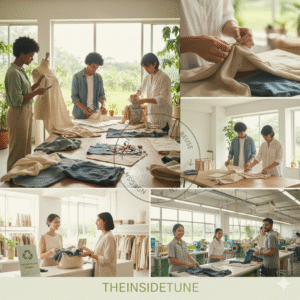
For too long, many industries have measured success by profit alone — how much they can sell, how fast they can grow. But the truth is, the future belongs to brands that measure success by impact — on people, on the planet, and on the generations yet to come.
So, what does leadership in circular and eco-design look like? It’s not about flashy marketing or green slogans. It’s about genuine transformation — a willingness to rethink every step of the journey, from the first sketch to the final sale (and even beyond).
Let’s explore how forward-thinking brands are making that shift — and how others can follow.
♻️ Designing for Longevity, Not Obsolescence
At the foundation of circular design is one simple idea: make things that last.
This means designing clothes, furniture, or products that can withstand wear, aging, and change — both physically and stylistically. Fast fashion and disposable design thrive on built-in obsolescence, where products are intentionally made to break, fade, or feel outdated. Circular brands reject that. They design for durability and timeless appeal.
Think of brands like Patagonia, which repairs clothing for free, or Eileen Fisher, whose “Renew” program refurbishes and resells used pieces. These aren’t gimmicks — they’re commitments to longevity.
When brands focus on quality and versatility, they naturally slow down consumption. A well-made product becomes something to treasure, not to toss.
🌿 Using Sustainable and Regenerative Materials
Materials are the foundation of every design story — and the choices brands make here are crucial.
Eco-design encourages brands to shift from harmful, synthetic, and resource-intensive materials toward those that are renewable, recycled, or regenerative.
Examples include:
-
Organic cotton that uses less water and no toxic pesticides
-
Tencel and bamboo fibers derived from responsibly managed forests
-
Recycled polyester made from discarded plastic bottles or ocean waste
-
Innovative materials like mushroom leather, hemp, or lab-grown textiles
Forward-thinking fashion houses like Stella McCartney and Allbirds have built entire collections around sustainable materials, proving that luxury and responsibility can coexist beautifully.
But material choice isn’t only about being “eco-friendly.” It’s also about creating circular flows — where materials can return safely to the environment or be endlessly reused without losing quality.
🧵 Closing the Loop: Take-Back and Repair Programs
Circular brands go beyond creating sustainable products — they take accountability for what happens after those products are sold.
That’s where take-back schemes and repair programs come in. Brands like Levi’s, H&M Conscious, and The North Face have introduced systems where customers can return used or damaged items. These are then repaired, resold, or recycled into new designs.
This not only keeps materials in circulation but also builds stronger brand loyalty. When a brand helps you extend the life of what you already own, it becomes more than a label — it becomes a partner in responsible living.
Imagine if every brand took responsibility for its products from creation to end-of-life. Landfills would shrink, waste would fall, and customers would feel more connected to the story behind every purchase.
🌸 Transparency and Traceability
Consumers today don’t just want to know what they’re buying — they want to know where it comes from.
True eco-design leadership requires transparency — showing the journey of materials, the working conditions of makers, and the environmental impact of each step.
This means adopting digital tools like QR codes or blockchain systems that allow customers to trace a product’s origin — from the farm where cotton was grown to the workshop where it was sewn.
Brands like Reformation and Nudie Jeans have mastered this. They publish impact reports, list their factories, and share how much water, energy, and CO₂ are saved with every purchase. This honesty builds trust — and trust is the new currency of modern branding.
Transparency isn’t just good ethics; it’s good business. It creates a deeper, emotional bond between consumers and brands, one built on respect rather than persuasion.
🌍 Rethinking Business Models: From Ownership to Access
Circular transformation doesn’t stop at design — it also reshapes how we buy. The traditional “buy-and-own” model is giving way to more fluid, sustainable systems like:
-
Rental services for special-occasion wear
-
Subscription models for rotating wardrobes
-
Resale platforms for pre-loved fashion
-
Refurbished or upcycled lines
Companies like Rent the Runway, Vinted, and The RealReal are proof that consumers are ready to embrace shared ownership. Meanwhile, brands like IKEA and Adidas are experimenting with repair-and-return systems that extend a product’s life while maintaining quality.
By turning products into services, brands can stay connected to customers long after the point of purchase — creating circular relationships, not one-time transactions.
🌾 Collaboration Over Competition
The circular and eco-design transformation isn’t something one company can do alone. It demands collaboration across industries — between designers, material scientists, suppliers, recyclers, and policymakers.
Some of the most inspiring innovations today are born from partnerships. For example:
-
Adidas x Parley for the Oceans turns ocean plastic into footwear.
-
H&M and Remondis collaborate to recycle textiles at scale.
-
The Ellen MacArthur Foundation works with global brands to redesign systems for circularity.
When brands collaborate, they accelerate progress. They share knowledge, technology, and passion — and in doing so, they rewrite the rules of what business can be.
🌼 Educating and Inspiring Consumers
No matter how sustainable a product is, its impact depends on how it’s used. That’s why circular leadership also means educating customers — not through guilt, but through inspiration.
Brands can guide consumers to wash clothes in colder water, repair instead of replace, recycle packaging correctly, or embrace pre-loved products.
When customers understand the value of circularity, they become active participants, not passive buyers. The relationship shifts from “seller–buyer” to partners in sustainability.
Fashion brands like Tentree, for example, plant ten trees for every item purchased — a tangible act that connects each sale to a larger purpose. Others include care labels that encourage sustainable habits, like “Love your clothes longer — wash cold, line dry, and repair when needed.”
It’s these small touches that make a big difference.
🌿 Measuring Impact and Staying Accountable
Real change can’t just be promised — it has to be proven. Leading brands now track and share their environmental and social impact openly. They use carbon accounting, life-cycle assessments, and sustainability reporting to ensure transparency.
This accountability helps brands evolve continuously and shows consumers that progress, not perfection, is what matters.
When companies set measurable goals — like achieving carbon neutrality, reducing waste by half, or using 100% recycled materials by a certain date — they turn ideals into action.
💚 The Human Side of Circular Leadership
Behind every sustainable innovation is a story — of artisans, designers, and communities. Circular brands honor this human connection. They support ethical working conditions, fair wages, and cultural craftsmanship that respects heritage and identity.
Eco-design isn’t just environmental — it’s socially conscious. It celebrates the people who make products with care and ensures that dignity and creativity are woven into every thread.
When brands champion both the planet and people, they create legacies — not just labels.
🌸 The Future of Brand Leadership
The circular and eco-design revolution isn’t about perfection. It’s about participation — and persistence. The most successful brands of the future won’t be those that simply sell the most; they’ll be the ones that create the most meaning, restore the most resources, and inspire the most change.
It’s a journey that demands courage — to slow down, to question habits, and to invest in innovation that lasts. But it’s also a journey full of hope. Because every small action — every sustainable fabric chosen, every repair offered, every transparent story told — adds up to a system where design truly serves life, not the other way around.
How Consumers Can Drive the Circular and Eco-Design Revolution
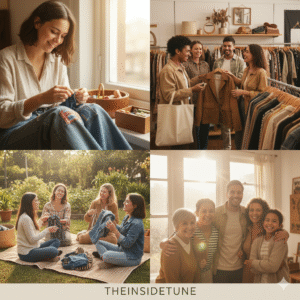
While brands may design the systems, consumers bring them to life.
Every purchase, every repair, every conscious choice — it all matters.
We often underestimate the power we hold as individuals, but the truth is, consumers shape markets. When we choose better, brands listen. When we demand change, industries transform. And when millions of us take small, consistent actions, the impact becomes unstoppable.
The circular and eco-design transformation isn’t just something happening in corporate boardrooms or design studios — it begins right in our homes, our wardrobes, our habits. It’s about rediscovering a mindful way of living and consuming — one that values quality, longevity, and purpose over endless newness.
🌿 Buy Less, Choose Better
It sounds simple, but it’s powerful: buy less, and choose better.
Every time we resist the temptation of a cheap, short-lived purchase, we send a message that we value craftsmanship and care over convenience. Slow down your shopping rhythm. Ask yourself before every purchase: Do I really need this? Will I wear or use it for years to come?
Choose timeless designs, durable fabrics, and ethically made items. These are the pieces that age gracefully and tell stories over time.
British designer Vivienne Westwood once said, “Buy less, choose well, make it last.” That phrase captures the entire spirit of circular living. It’s not about deprivation — it’s about appreciation.
🧵 Extend the Life of What You Own
Circular living starts with what’s already in your hands. The most sustainable item is the one you already have.
Take care of your clothes, furniture, and gadgets. Learn simple repairs — sewing on a button, patching a tear, polishing leather, tightening a screw. These small acts of maintenance reconnect you with the joy of keeping things alive.
And if something no longer fits your lifestyle, don’t throw it away.
Give it new life — donate it, swap it, resell it, or upcycle it into something else. A pair of worn-out jeans can become a tote bag. A broken chair can be restored or turned into art.
Extending a product’s life by just nine months can reduce its carbon footprint by up to 30%. That’s how powerful these simple habits are.
🌸 Embrace Secondhand and Pre-Loved Shopping
Gone are the days when secondhand meant second-best. Today, pre-loved fashion is cool, conscious, and creative.
Vintage stores, thrift markets, and online resale platforms like Depop, Vinted, and The RealReal have transformed the way we shop. Each item you buy secondhand prevents new resources from being extracted and reduces waste from landfills.
Beyond the environmental benefit, secondhand shopping offers something truly special — uniqueness. No one else will have that exact jacket, that perfectly worn-in pair of jeans, or that vintage bag with character. It’s individuality with integrity.
And the best part? It keeps beautiful pieces in circulation. When you buy pre-loved, you give design a second chapter.
🌎 Support Brands That Do Better
Every purchase is a vote. When you support brands that practice circular and eco-design, you’re voting for a greener, fairer system.
Look for labels that share where their materials come from, how their workers are treated, and what steps they’re taking to minimize waste. Transparency is key — if a brand hides its process, it’s often a red flag.
Some questions you can ask before buying:
-
Is this made from sustainable or recycled materials?
-
Does the brand offer take-back, repair, or recycling programs?
-
Do they pay fair wages to workers?
-
Are they honest about their environmental goals?
When consumers start asking these questions collectively, brands are forced to evolve. Every ethical purchase amplifies a message of accountability.
🪡 Join the Repair, Swap, and Share Movement
One of the most beautiful aspects of the circular revolution is community. Around the world, small local initiatives are popping up — repair cafés, clothing swaps, community upcycling workshops, and tool libraries — all dedicated to sharing, fixing, and reducing waste together.
By taking part in these, you not only save money but also build connections. You learn, exchange, and experience the joy of collaboration.
Repairing something with others is deeply fulfilling — it turns sustainability into a shared human experience rather than a solo effort.
Imagine a world where every neighborhood has a repair café or a local clothing exchange — where sustainability isn’t a niche activity, but a social norm. That’s the future we can build together.
🌿 Reconnect Emotionally with What You Own
In our fast-paced world, we often forget the emotional side of our belongings. Circular living invites us to reconnect with our things — to see them not as disposable, but as companions.
Think about the clothes that hold memories — your first interview outfit, your travel backpack, your grandmother’s scarf. These pieces carry stories that deserve to be cherished, not replaced.
When we value emotional durability, we naturally consume less. Because we don’t just own things — we build relationships with them.
That’s what makes circular living deeply human — it’s not about sacrifice, but about meaning.
🌼 Spread the Word and Inspire Others
Change grows through conversation. Talk about sustainability with friends, share your favorite eco brands, or post about your thrift finds. Normalize it. The more we talk about circularity, the faster it becomes part of culture.
Inspiration is contagious. When someone sees you rewearing an outfit proudly, repairing a jacket instead of replacing it, or supporting a local eco-designer, it sparks curiosity — and maybe even action.
Every small act of advocacy matters. Because revolutions don’t start in governments or corporations — they start with people talking, learning, and acting differently.
🌏 Rethink Your Definition of “New”
In the linear world, “new” means shiny, untouched, straight from the store. But in the circular world, “new” takes on a richer meaning. “New” can be something renewed, repaired, reimagined.
When we start to see beauty in imperfection — in the patch on a favorite shirt, the polish on an old table, or the creativity of an upcycled piece — we redefine what value looks like.
This shift doesn’t just help the planet. It helps us slow down, reconnect, and find joy in the little things again.
💚 Remember — Progress, Not Perfection
The path to circular living isn’t about doing everything right. It’s about doing something — and doing it consistently.
Start small: bring a reusable bag, fix a loose button, support one ethical brand, or shop secondhand once a month. Over time, these actions grow into habits — and habits create culture.
Sustainability isn’t a lifestyle reserved for experts; it’s a mindset built on intention and compassion.
As consumers, we hold incredible influence. We can shift industries not through pressure, but through participation. The power of circular transformation lies in collective effort — in millions of small, meaningful acts that reshape the world from the ground up.
🌸 A Shared Future
The circular revolution isn’t about guilt or perfectionism — it’s about hope. It’s about realizing that every product, every choice, every habit has the potential to contribute to something bigger.
When we act consciously, we don’t just change our closets or homes — we change the future. Together with brands, we can design a world where beauty, purpose, and responsibility exist in perfect harmony.
And the best part? It starts right where you are — with the next thing you choose to buy, keep, or repair.
Real-World Examples — Brands and Communities Pioneering Circular and Eco-Design
The circular and eco-design revolution isn’t just a dream—it’s happening right now, all over the world. From high-end fashion houses to small grassroots projects, innovators are proving that design can be both beautiful and responsible. These examples show that sustainability doesn’t mean sacrificing style or success — it means redefining what success looks like.
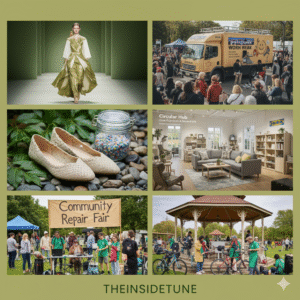
Here are some of the most inspiring examples of how creativity and conscience are coming together to reshape industries — one design at a time.
👗 Stella McCartney – Leading Luxury into the Future
If there’s one name that consistently sets the standard for sustainable luxury, it’s Stella McCartney. Long before “sustainable fashion” became a buzzword, McCartney built her brand on ethical and circular values.
Her collections reject leather, fur, and animal-derived materials — proving that cruelty-free can also be chic and high-end. She’s constantly exploring innovative textiles like Mylo™, a mushroom-based leather alternative, and Econyl, a regenerated nylon made from ocean waste.
But it’s not just about materials. Stella McCartney champions circular systems — encouraging repairs, resale, and recycling. Her partnership with The Ellen MacArthur Foundation highlights how fashion can design out waste and pollution entirely.
In her own words:
“The future of fashion has to be circular. The only waste we should create is imagination.”
That mindset is shaping a new era for luxury — one where responsibility and elegance coexist.
🧥 Patagonia – Repair, Reuse, and Respect for the Planet
Few brands walk their talk as authentically as Patagonia. This outdoor company has built its entire identity around environmental activism and longevity.
Their famous “Don’t Buy This Jacket” campaign challenged consumers to think before purchasing — a bold move that actually strengthened their reputation.
Patagonia’s Worn Wear Program lets customers repair, resell, or recycle used gear. They even run repair trucks that travel across the U.S. and Europe, helping people fix outdoor clothing for free.
Their commitment goes beyond products — the brand donates 1% of sales to environmental causes and supports grassroots movements fighting for nature.
Patagonia reminds the world that true success isn’t just measured in profit, but in planetary contribution.
👟 Adidas x Parley for the Oceans – Turning Waste into Performance
When global sportswear giant Adidas teamed up with environmental group Parley for the Oceans, they created one of the most visible examples of circular innovation at scale.
The collaboration’s goal? To transform plastic waste from beaches and coastal communities into high-performance sportswear.
Every pair of Adidas x Parley sneakers is made using upcycled marine plastic — preventing millions of plastic bottles from entering the ocean. Since 2015, this partnership has repurposed over 140 million plastic bottles into sneakers, jerseys, and apparel.
It’s not just recycling — it’s reimagination. The campaign shows that major corporations can become part of the solution when they combine design, technology, and ethics.
🧵 The Ellen MacArthur Foundation – Building a Global Circular Blueprint
While brands act on the ground, organizations like The Ellen MacArthur Foundation are working on a global scale to rewrite the rules of design.
Their Circular Economy Initiative partners with governments, universities, and companies to redesign systems that minimize waste and regenerate natural resources.
They’ve been instrumental in pushing industries — especially fashion — to adopt “design for reuse” principles, create new business models like leasing and rental, and promote full transparency in supply chains.
Their message is simple yet revolutionary:
“In nature, nothing is wasted. Our economy should be no different.”
Thanks to their advocacy, circular design is now part of the world’s most important sustainability conversations — from the UN Climate Summits to corporate sustainability reports.
♻️ IKEA – Designing Furniture for Circular Living
The world’s largest furniture retailer, IKEA, has made an ambitious commitment: by 2030, all their products will be based on renewable or recycled materials.
They’ve already introduced furniture that can be easily disassembled, repaired, and recycled — turning their iconic minimalist design into something truly future-ready.
IKEA’s “Buy Back & Resell” program encourages customers to return used furniture instead of discarding it. These items are then repaired and resold at lower prices, extending their life cycle and reducing waste.
The brand also invests heavily in renewable energy and sustainable forestry, making circularity a business model rather than a marketing slogan.
👠 Rothy’s – Turning Waste into Everyday Elegance
Rothy’s, a footwear and accessories brand from San Francisco, has captured global attention by transforming plastic waste into chic, comfortable shoes.
Each pair is made from recycled plastic bottles, spun into soft, durable thread. Their shoes are 3D-knit, a process that eliminates fabric waste entirely. Even the insoles and packaging are sustainable.
What makes Rothy’s special is their closed-loop system — customers can return worn-out shoes, which are then recycled into new pairs. That’s circular fashion in action.
Stylish, comfortable, and ethical — Rothy’s shows how eco-design can appeal to modern consumers without compromise.
🌸 Small Local Heroes and Community Projects
Not all change comes from global brands — some of the most creative work happens at the grassroots level.
In Budapest, Remake Hub helps local designers turn textile waste into new collections. In London, The Restart Project hosts community repair events for electronics, teaching people to fix rather than replace.
Across Asia, Africa, and South America, countless artisans are using traditional craft techniques to create sustainable products — blending heritage with innovation.
These small-scale efforts prove that circularity is not a Western concept or a corporate trend. It’s a universal movement, rooted in resourcefulness, creativity, and care.
🌱 Global Fashion Activism and Circular Awareness Campaigns
Movements like Fashion Revolution and #WhoMadeMyClothes are giving consumers a voice — urging them to demand transparency and ethical production from brands.
Meanwhile, organizations such as Global Fashion Agenda and Textile Exchange are helping shape international policies for sustainable textiles, recycling systems, and fair labor.
Their collective work is pushing the entire fashion ecosystem to become more circular, inclusive, and transparent.
🌏 Lessons from Nature – The Original Circular Designer
If there’s one designer that’s truly circular, it’s nature itself.
In natural ecosystems, nothing is wasted — everything regenerates. Leaves fall, decompose, and feed new life. Animals migrate and redistribute nutrients. It’s a perfect loop of creation and renewal.
Circular design simply borrows from this wisdom. It’s about designing products, systems, and experiences that behave more like ecosystems — where waste becomes a resource, and endings become beginnings.
When brands and communities look to nature as their teacher, they discover the blueprint for resilience, harmony, and timeless beauty.
🌿 A Collective Vision
These pioneers — from Stella McCartney to community repair cafés — show us that the circular and eco-design transformation is already real.
It’s not an abstract ideal or a distant goal; it’s happening here and now, in every corner of the world. Each innovation, each repair, each ethical choice brings us closer to a system that works with the planet, not against it.
But this transformation only thrives when everyone plays their part — brands, designers, consumers, policymakers, and communities alike.
Together, we can make “waste” an obsolete word and turn design into a force for regeneration.
The Role of Technology and Innovation in Circular Design
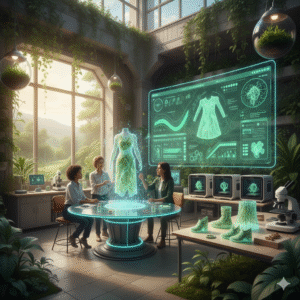
The circular revolution isn’t just powered by creativity and conscience — it’s also driven by technology.
In fact, the most exciting breakthroughs in sustainability today are happening at the intersection of design, science, and innovation.
From AI systems that predict waste patterns to new materials grown in labs, technology is helping designers and brands imagine a future where sustainability is not an afterthought but the foundation of creation.
Let’s explore how tech is reshaping the very meaning of design — making it smarter, cleaner, and infinitely more circular.
🌱 Smart Materials: The New Building Blocks of Circular Design
One of the most transformative changes in eco-design is happening at the material level. Scientists and designers are working together to create next-generation materials that are renewable, biodegradable, and endlessly recyclable.
Take biomaterials, for example — fabrics and fibers grown from living organisms like mushrooms, algae, and bacteria.
-
Mylo™ leather, made from mycelium (the root structure of mushrooms), mimics the texture and durability of animal leather without harming animals or ecosystems.
-
AlgiKnit, a startup in New York, spins kelp and seaweed into yarn that’s soft, compostable, and carbon-negative.
-
In Italy, Orange Fiber turns discarded citrus peels into silky, breathable fabrics.
These innovations close the loop between nature and design, turning waste into resources and showing how the future of fashion and furniture could literally grow from the earth itself.
🧬 3D Printing: Design Without Waste
Traditional manufacturing often produces massive amounts of leftover material — scraps that end up as waste. 3D printing, or additive manufacturing, flips this logic completely.
By building products layer by layer, it uses exactly the amount of material needed — no more, no less.
Brands like Adidas and Rothy’s already use 3D printing to craft shoes with zero fabric waste. Designers can experiment with complex patterns, textures, and structures that would be impossible using conventional methods — all while minimizing environmental impact.
In the furniture and architecture industries, 3D printing is being used to create structures from recycled plastics, wood composites, and even sand. It’s precision meets purpose — creativity without compromise.
🔄 Artificial Intelligence and Data Analytics
AI might not sound glamorous, but it’s becoming a quiet hero in sustainable design.
By analyzing huge amounts of data — from production patterns to consumer behavior — AI helps designers and brands reduce waste, predict trends, and optimize supply chains.
For example:
-
AI systems can forecast how much fabric a fashion line will actually sell, preventing overproduction.
-
Algorithms can identify materials that can be repurposed or recycled efficiently.
-
Smart platforms like CircularID™ allow brands to tag products with digital “passports” that store information about where and how they were made — enabling easier recycling and reuse later.
Essentially, AI helps design smarter, make wiser decisions, and close loops that used to stay open.
It’s not replacing human creativity — it’s enhancing it.
🧾 Blockchain and Transparency
One of the biggest challenges in circular design is traceability — knowing where materials come from, how they’re made, and where they go at the end of their life cycle.
This is where blockchain comes in.
Blockchain technology creates transparent, tamper-proof digital records of every step in a product’s journey — from raw material to final sale.
Brands like Prada, LVMH, and Everledger are experimenting with blockchain systems that let consumers scan a tag and instantly see a product’s history — who made it, under what conditions, and how it can be reused or recycled.
This level of honesty builds trust and empowers consumers to make informed, ethical choices.
Transparency isn’t just good for the planet — it’s good for business.
🧠 Virtual Design and Digital Prototyping
In the past, designing a new collection or product required countless physical samples — consuming materials, time, and energy.
Now, thanks to virtual prototyping tools like CLO3D, Browzwear, and Adobe Substance 3D, designers can create hyper-realistic digital garments and products before ever producing a single item.
These tools allow experimentation without waste — tweaking fits, fabrics, and colors in a virtual environment. Once finalized, only the best designs move into production.
Digital design isn’t just eco-friendly — it’s democratizing creativity. Small designers can now test ideas and share collections globally without huge costs or wasteful sampling.
🌿 Recycling Technologies That Go Beyond the Bin
Traditional recycling has its limits — especially for blended materials like polyester-cotton fabrics. But new recycling technologies are breaking barriers that once seemed impossible.
-
Chemical recycling can now separate and regenerate fibers, turning old clothes into high-quality new ones.
-
Companies like Renewcell (Sweden) and Worn Again Technologies (UK) are leading the charge, creating circular systems where textiles never truly “die.”
-
Even plastic, once considered a recycling nightmare, is being reinvented through enzymatic recycling — a process that breaks down polymers at a molecular level, allowing endless reuse.
This is not just waste management — it’s waste transformation.
⚙️ Digital Fashion and the Metaverse Revolution
Here’s an unexpected but fascinating twist: some of the most sustainable fashion pieces today don’t exist in the physical world at all.
Digital fashion — clothing designed purely for virtual environments — is gaining momentum through platforms like DressX and The Fabricant.
People can “wear” these digital outfits online, for social media posts or virtual events, without producing any physical waste.
It’s fashion meets fantasy — but also a way to radically reduce overproduction. When you can satisfy your creative expression digitally, physical consumption naturally slows down.
While it won’t replace real-world garments entirely, digital fashion offers a new way to blend art, technology, and sustainability.
🌸 Circular Design Platforms and Sharing Systems
The sharing economy — supported by apps and digital platforms — is another cornerstone of the circular revolution.
Companies like Rent the Runway, Vigga, and By Rotation allow users to rent or share clothes instead of buying them.
Similarly, platforms like Back Market promote refurbished electronics, giving gadgets a second life.
These systems use technology to extend product life cycles, reduce waste, and make sustainable choices more accessible and affordable.
Digital innovation is proving that convenience and responsibility can go hand in hand.
🌏 Regenerative Design and Smart Cities
Looking at the bigger picture, technology is helping architects and urban planners build regenerative cities — environments designed to give back more than they take.
Sensors monitor energy efficiency, smart grids redistribute power, and circular construction techniques use renewable or recycled materials to create buildings that can be disassembled and reused in the future.
Imagine a city where nothing goes to waste — where the walls of one building become the foundations of another, and where resources flow in loops, not lines. That’s the vision technology is making possible.
🌿 A Future Built on Connection
What’s truly beautiful about this intersection of design and technology is how it reconnects humans with purpose.
Technology isn’t just about efficiency — it’s about enabling care. It gives designers the tools to think beyond profit, to design with empathy for both people and planet.
As innovation continues, circular design will become not just a trend, but a new normal — a living ecosystem of creativity, responsibility, and regeneration.
The future of design isn’t just smart — it’s sustainable, soulful, and deeply human.
Policy, Education, and Global Collaboration for a Circular Future
While innovation and consumer action are vital, true transformation needs structure — systems that encourage and sustain change.
That’s where policy, education, and global collaboration come in.
These three pillars form the backbone of the circular revolution. They create the frameworks, awareness, and shared momentum that make it possible for brands, communities, and individuals to move together toward a sustainable future.
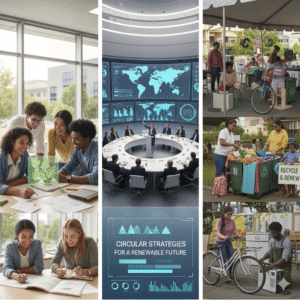
Let’s explore how governments, schools, and global partnerships are laying the groundwork for a world where circular design becomes not just an option — but the standard.
🏛️ Policy: Building the Framework for Change
Governments play a key role in shaping how industries operate. For decades, most policies favored linear growth — more production, more consumption, more profit. But that’s changing rapidly.
Many countries are now realizing that circularity isn’t just good for the planet — it’s good economics. By designing systems that reuse materials, minimize waste, and support innovation, nations can create new jobs, strengthen local industries, and reduce dependence on raw resources.
🌍 European Union: Leading the Circular Policy Wave
The European Union is one of the strongest global advocates for circularity. Its Circular Economy Action Plan sets ambitious goals to make all packaging recyclable by 2030, reduce textile waste, and promote eco-design across industries.
The EU’s Eco-design Directive also pushes manufacturers to create products that are repairable, upgradable, and energy-efficient — giving consumers more rights to repair and reuse.
This isn’t just regulation — it’s a roadmap for how policy can drive innovation.
🇳🇱 The Netherlands: A Fully Circular Vision by 2050
The Netherlands is another leader in circular policy. The Dutch government has pledged to become a 100% circular economy by 2050, focusing on sustainable construction, renewable energy, and waste-free cities.
Initiatives like “Circular Amsterdam” are transforming urban infrastructure — from how buildings are made to how food and materials flow through the city.
🌏 Beyond Europe: Global Momentum
Countries like Japan, Canada, Kenya, and Singapore are also investing in circular systems — from e-waste recycling policies to sustainable urban planning.
The idea is spreading: the world is realizing that a waste-free economy is not only environmentally necessary but economically smart.
🎓 Education: Teaching the Next Generation of Circular Thinkers
The future of circular design depends not only on technology and policy — but on people who understand it, believe in it, and can apply it creatively.
That’s why education is a crucial part of this transformation. Around the world, universities, design schools, and even primary classrooms are integrating sustainability and circularity into their learning.
👩🎓 Designing for a New Mindset
Top institutions like Parsons School of Design, Ellen MacArthur Foundation’s Learning Hub, and University of the Arts London (UAL) now offer specialized programs in Circular Design, Sustainable Fashion, and Regenerative Innovation.
These programs encourage students to think holistically — to consider not just aesthetics, but the social and environmental impact of every design decision.
Students learn that being a good designer today means being a problem solver for the planet.
🏫 Early Education and Awareness
Change starts even earlier. Some countries are weaving sustainability education into their national curriculums — teaching children about recycling, renewable energy, and environmental ethics from a young age.
When kids grow up understanding that waste is a design flaw, not a necessity, they naturally become part of the solution.
Education is planting seeds that will grow into the next generation of eco-innovators, engineers, and ethical consumers.
🌎 Global Collaboration: Working Together for Shared Impact
Circularity doesn’t stop at borders. The problems we face — climate change, pollution, deforestation — are global, and so are the solutions.
That’s why international collaboration is at the heart of this movement. Governments, NGOs, and industries are forming alliances to share research, technology, and strategies that accelerate global progress.
🤝 United Nations and Sustainable Development Goals (SDGs)
The UN’s Sustainable Development Goals (SDGs) — especially Goals 12 (Responsible Consumption and Production) and 13 (Climate Action) — provide a shared vision for a circular and sustainable world.
Under these goals, initiatives like the UN Environment Programme (UNEP) and UNIDO’s Global Circular Economy Platform are supporting countries in developing national circular strategies.
🌍 The Global Fashion Agenda and Ellen MacArthur Foundation
These organizations have become leading forces in guiding industries — particularly fashion and textiles — toward circular models.
Their annual Copenhagen Fashion Summit and Circularity Global Reports bring together policymakers, designers, and activists to share solutions and track progress.
🌐 Cross-Industry Collaboration
It’s not just about fashion or manufacturing. Circular thinking is now influencing construction, automotive design, food systems, and technology.
For instance, the Circular Electronics Partnership brings together major tech brands like Dell, Google, and Microsoft to make electronic devices easier to repair, recycle, and reuse.
By connecting across industries, we multiply impact and move faster toward a shared goal: a planet where resources are used wisely and endlessly.
🌿 The Importance of Cultural and Local Collaboration
Global policies are essential, but so are local cultures and traditions. Around the world, communities have long practiced resourcefulness — repairing, reusing, and sharing long before the term “circular economy” existed.
In rural Asia, Africa, and South America, people still mend clothes, repurpose containers, and exchange goods within tight-knit networks. These age-old habits are a living example of what circularity looks like in practice.
By blending modern technology with traditional wisdom, we can build circular systems that are both innovative and inclusive — respectful of local values while addressing global challenges.
🌏 The Power of Shared Knowledge
One of the most transformative aspects of the circular movement is how open and collaborative it is.
Designers share blueprints. Scientists share research. Activists share data. Instead of competing, they’re co-creating — because the mission is too big for anyone to tackle alone.
Open-source platforms, online communities, and design databases are spreading circular principles worldwide. This culture of sharing ensures that even small startups or developing nations can access the tools to innovate sustainably.
When we share knowledge, we multiply power — and that’s the essence of circularity.
🌸 A Shared Future: From Policy to Practice
Policy creates direction, education builds capacity, and collaboration creates connection. Together, they form the foundation of a circular civilization — one where sustainability is not just a niche movement, but a shared human value.
Imagine a world where every school teaches circular design, every government supports eco-innovation, and every global summit commits to regeneration rather than exploitation.
That’s not a distant dream — it’s a direction we’re already moving toward.
The circular future isn’t just about changing how we make things — it’s about changing how we think, learn, and work together.
The Business Case for Circular and Eco-Design
For years, sustainability was seen as a “nice-to-have.” Something brands did for good PR or to appeal to niche markets. But that era is gone.
Today, circularity is a core business strategy, and eco-design has become a new benchmark of excellence.
Forward-thinking companies now realize that sustainability and profitability are not enemies — they are powerful partners. When a brand invests in circular models, it’s not just saving the planet; it’s also building resilience, innovation, and long-term value.
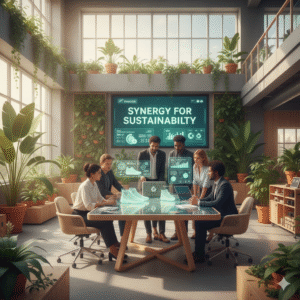
💡 Profitability Through Resource Efficiency
The most immediate and measurable benefit of circular design lies in efficiency.
Traditional linear models waste materials and energy — and that waste costs money. By contrast, circular systems reduce waste at every stage: from sourcing and production to distribution and disposal.
When companies reuse or recycle their materials, they:
-
Spend less on raw resources.
-
Cut energy and transportation costs.
-
Reduce dependency on volatile global supply chains.
For example, Interface, a global flooring company, redesigned its entire manufacturing process to minimize waste and use recycled materials. The result?
A 48% reduction in carbon footprint and millions saved annually in resource costs.
Circular thinking transforms waste from a cost center into a value generator. What was once discarded becomes raw material for something new — a concept that’s rewriting the rules of profitability.
🔁 Brand Loyalty and Consumer Trust
Today’s consumers are more informed and values-driven than ever.
They’re not just buying products — they’re buying what a brand stands for.
Surveys show that over 70% of millennials and Gen Z prefer to purchase from sustainable brands, and many are even willing to pay a premium for eco-friendly products.
Brands that adopt circular and eco-design gain more than just sales — they earn trust. And trust is the most valuable currency in today’s competitive market.
Take Patagonia, for instance. Their “Don’t Buy This Jacket” campaign urged consumers to repair and reuse old products rather than buy new ones. The campaign was bold — even counterintuitive — yet it strengthened their reputation and increased customer loyalty dramatically.
Why?
Because authenticity sells. Consumers reward honesty and responsibility. When brands align profit with purpose, they don’t just attract customers — they build communities.
🌍 Innovation and Competitive Advantage
Circular design challenges companies to think differently, which naturally leads to innovation.
Instead of designing for end-of-life, they design for continuous life — for repair, reuse, remanufacture, and regeneration.
This mindset pushes businesses to discover new materials, develop modular systems, and create services instead of products (like clothing rental, subscription-based electronics, or furniture take-back programs).
One striking example is Philips Lighting, which now offers “Light as a Service.”
Instead of selling bulbs, Philips installs and maintains lighting systems, and customers pay only for the light they use. When bulbs reach the end of life, Philips collects, refurbishes, and reuses materials — keeping everything in the loop.
That’s circular business in action — reducing waste while building recurring revenue.
Innovation thrives when creativity meets responsibility. The brands leading the future are those turning sustainability challenges into design opportunities.
🔋 Building Resilience Against Market Shocks
In a world of supply chain disruptions, raw material shortages, and environmental crises, circular design gives businesses a major advantage — resilience.
By sourcing locally, reusing materials, and minimizing dependency on global extraction, companies can operate more steadily even in turbulent markets.
For example, during the COVID-19 pandemic, brands with closed-loop supply systems and local production hubs recovered faster than those dependent on overseas raw materials.
Circular systems are flexible, adaptive, and future-ready. They’re built not just to survive — but to evolve.
📈 Long-Term Growth and Investor Confidence
Investors today are increasingly prioritizing ESG (Environmental, Social, and Governance) factors when choosing where to put their money.
Circular and eco-design practices signal to investors that a company is forward-thinking, compliant with future regulations, and ready for sustainable growth.
In fact, sustainable funds outperformed traditional funds in multiple markets over the past five years — showing that responsibility and returns can go hand in hand.
Major investment firms like BlackRock and Goldman Sachs now encourage companies to adopt circular frameworks as part of their sustainability portfolios.
This shift means one thing: circularity isn’t just about ethics anymore — it’s about economic intelligence.
🧵 New Business Models: From Ownership to Access
The circular economy is also reshaping how we think about ownership.
In a world where resources are finite, access is often smarter than possession.
Brands like Rent the Runway, VIGGA, and The RealReal are redefining fashion consumption through rental, resale, and shared ownership models.
This not only reduces waste but opens up entirely new revenue streams.
Why sell a product once when you can earn from it multiple times?
By designing durable, timeless, and reusable goods, brands can create products that generate ongoing value — economically and environmentally.
Circular business models turn consumption into connection — between users, between generations, and between people and the planet.
🌱 Collaboration and Transparency as New Business Ethics
The rise of circularity has introduced a new kind of competition — cooperation.
Brands are realizing that sharing technologies, open-sourcing materials, and collaborating with startups can actually accelerate growth and strengthen the entire ecosystem.
For instance, Adidas and Allbirds collaborated to produce the world’s lowest carbon-footprint running shoe — proving that collaboration, not secrecy, is the new path to innovation.
Transparency also matters more than ever.
Consumers now expect brands to show exactly how and where their products are made. Certifications like Cradle to Cradle, B Corp, and Fair Trade are helping establish trust and accountability.
Circularity invites honesty — because openness builds stronger businesses.
💬 The Emotional Connection: Meaning in Consumption
Beyond the numbers, there’s something deeply emotional about circular and eco-design.
When consumers buy something that lasts, that can be repaired or passed down, they form an attachment to it.
It becomes a story, not just a product.
This emotional connection makes consumption more mindful — and creates deeper brand relationships.
Think about Levi’s jeans — repaired, reworn, personalized — or a refurbished Apple device that gets a second life. These stories reflect values of continuity, respect, and care.
When business is guided by empathy, the world responds with loyalty.
🌿 Circular Economy as the Future of Business Strategy
The shift toward circular design isn’t a passing trend — it’s a structural transformation of how business is done.
In a future shaped by resource scarcity, climate challenges, and conscious consumers, only the companies that integrate sustainability at their core will thrive.
Circularity offers:
-
Lower costs through efficiency.
-
Higher loyalty through authenticity.
-
Continuous innovation through design thinking.
-
Stronger reputation through purpose-driven action.
This isn’t just good for the planet. It’s good business — sustainable in every sense of the word.
🌸 The Takeaway: Redefining Success
In the past, business success was measured by growth and output — how much we could produce and sell.
Now, it’s about impact and longevity — how well we can create, reuse, and regenerate.
The brands of the future will be those that understand one timeless truth:
profit is powerful, but purpose makes it last.
Circular and eco-design are not about sacrifice — they’re about reimagining prosperity in a way that works for everyone, including the planet.
The Call to Action — How Brands and Consumers Can Join the Circular Revolution
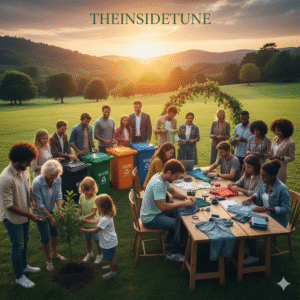
After exploring the power of circular design, sustainable innovation, and global collaboration, one truth stands out clearly:
We are all part of this transformation.
The shift toward circular and eco-design isn’t happening in boardrooms or laboratories alone — it’s happening in how we live, buy, create, and care.
This final section is not just an ending — it’s an invitation.
An invitation to brands, designers, policymakers, educators, and consumers to turn intention into impact.
💚 For Brands: Be the Leaders of Change
Brands have the platform, resources, and influence to make sustainability mainstream. But leadership today means more than profit — it means purpose with performance.
Here’s how businesses can truly lead the way:
🌱 Redesign for Circularity
Start from the very beginning — the design phase.
Ask: How can this product live longer? Be repaired, reused, or recycled?
Rethink materials, minimize packaging, and design for durability and disassembly.
Brands like IKEA, Adidas, and Stella McCartney are already proving that circular design can scale globally while maintaining creativity and profit.
🔁 Implement Take-Back and Reuse Systems
Don’t let your products end their story in landfills. Create return, repair, and refurbish programs to close the loop.
For example, Apple’s Trade-In program collects old devices for refurbishment, and H&M’s garment recycling bins encourage customers to return clothes instead of discarding them.
Circular systems make sustainability visible — and invite consumers to participate.
💬 Be Transparent and Accountable
Consumers no longer expect perfection — they expect honesty.
Share where your materials come from, how your workers are treated, and what your sustainability goals are.
Transparency builds credibility.
When brands open up, consumers lean in.
🤝 Collaborate for Greater Impact
Join hands with others in your industry, share insights, and co-create sustainable solutions.
Partnerships between fashion, tech, and manufacturing sectors are showing how shared goals amplify progress.
Because circularity isn’t a competition — it’s a collective mission.
🌍 Invest in Education and Community
Support sustainability education programs, local repair workshops, or eco-design incubators.
Empowering others multiplies your impact — it plants seeds of change that grow far beyond your own brand.
🛍️ For Consumers: The Everyday Heroes of the Circular Movement
Change doesn’t only start in factories or design studios — it begins in our daily choices.
Each purchase, each habit, each decision is a vote for the kind of world we want to live in.
Here’s how consumers can lead from the ground up:
♻️ Buy Less, Choose Better
The simplest act of sustainability is mindful consumption.
Before buying, ask: Do I really need this? Can I repair what I already own? Can I buy secondhand or rent instead?
Supporting ethical, durable, and repairable products sends a clear message: waste is out, consciousness is in.
🧵 Care and Repair
Learn to care for what you have.
Mend torn clothes, upcycle old furniture, and repair broken gadgets instead of replacing them.
Every time you repair, you resist the throwaway culture — and participate in the circular flow of life.
💡 Support Circular Brands
Spend your money where your values align.
From Patagonia’s Worn Wear to Vinted, ThredUp, and Refurbed, countless companies now make it easy to buy sustainably.
Each purchase is more than a transaction — it’s a statement of hope.
🗣️ Raise Awareness
Talk about sustainability with your friends, family, and online communities.
The more we normalize eco-conscious living, the faster it becomes the new standard.
Your voice has power — and it spreads ripples of change.
🌍 Hold Brands Accountable
Ask questions. Demand transparency.
When consumers insist on ethical and sustainable practices, brands listen.
Collective demand shapes corporate behavior — and drives systemic change.
🌿 For Designers and Innovators: Creativity with Conscience
Designers hold the blueprint of the future.
Your creativity can either fuel waste — or create wonder.
Embrace eco-design principles: design for longevity, circular flow, and emotional connection. Experiment with biodegradable materials, modular systems, and closed-loop ideas.
Every product you design can be a message of responsibility and beauty combined.
As designer Dieter Rams said, “Good design is as little design as possible — but as much care as you can give.”
📚 For Educators and Policymakers: Build the Foundation for Change
Policy and education shape how societies think, behave, and evolve.
Educators can nurture sustainability values early on, while policymakers can create incentives that make circular practices accessible and rewarding.
-
Introduce eco-literacy in schools.
-
Offer grants and tax breaks for circular businesses.
-
Enforce regulations on waste reduction, packaging, and carbon emissions.
When systems support sustainability, individuals naturally follow.
True change happens when awareness meets opportunity.
🔄 Collective Action: The Power of “We”
No single brand, designer, or individual can fix the climate crisis alone.
But together, our actions connect like threads — weaving a powerful fabric of change.
Circularity is about connection: between people, between industries, between generations.
It’s a shared responsibility and a shared opportunity.
Imagine a future where:
-
Every city has local repair hubs and recycling centers.
-
Every product is made to last, not to break.
-
Every child learns that waste is a resource, not rubbish.
This isn’t a fantasy — it’s a movement already in motion.
And every one of us has a place in it.
💬 The Emotional Truth: We Owe It to the Future
At its core, the circular revolution isn’t just about sustainability — it’s about love.
Love for the planet that shelters us, love for the generations that will come after us, and love for the creativity that defines us as humans.
We owe it to our children to hand over not a planet of scarcity and pollution, but one of abundance and renewal.
Every time we choose circularity — as brands, as designers, as consumers — we choose hope over harm.
We prove that progress and compassion can coexist beautifully.
🌸 The Time Is Now
The question is no longer if we can change — but when.
And the answer is simple: now.
The tools exist. The knowledge exists. The desire exists.
All that’s needed is the courage to act.
So let this be the moment we stop being observers and become participants.
Let this be the decade we design a world where waste is obsolete, and renewal is the norm.
Circular and eco-design aren’t the future — they’re the present calling us to act.
🌿 Final Takeaway
“We don’t inherit the Earth from our ancestors — we borrow it from our children.”
— Native American Proverb
The circular revolution begins with awareness but lives through action.
Whether you’re a brand rethinking your production, a designer sketching your next masterpiece, a teacher inspiring young minds, or a consumer making mindful choices — your role matters.
Together, we can redesign the story of our planet — not as one of depletion, but of regeneration.
Not as an ending, but a beautiful continuation.


